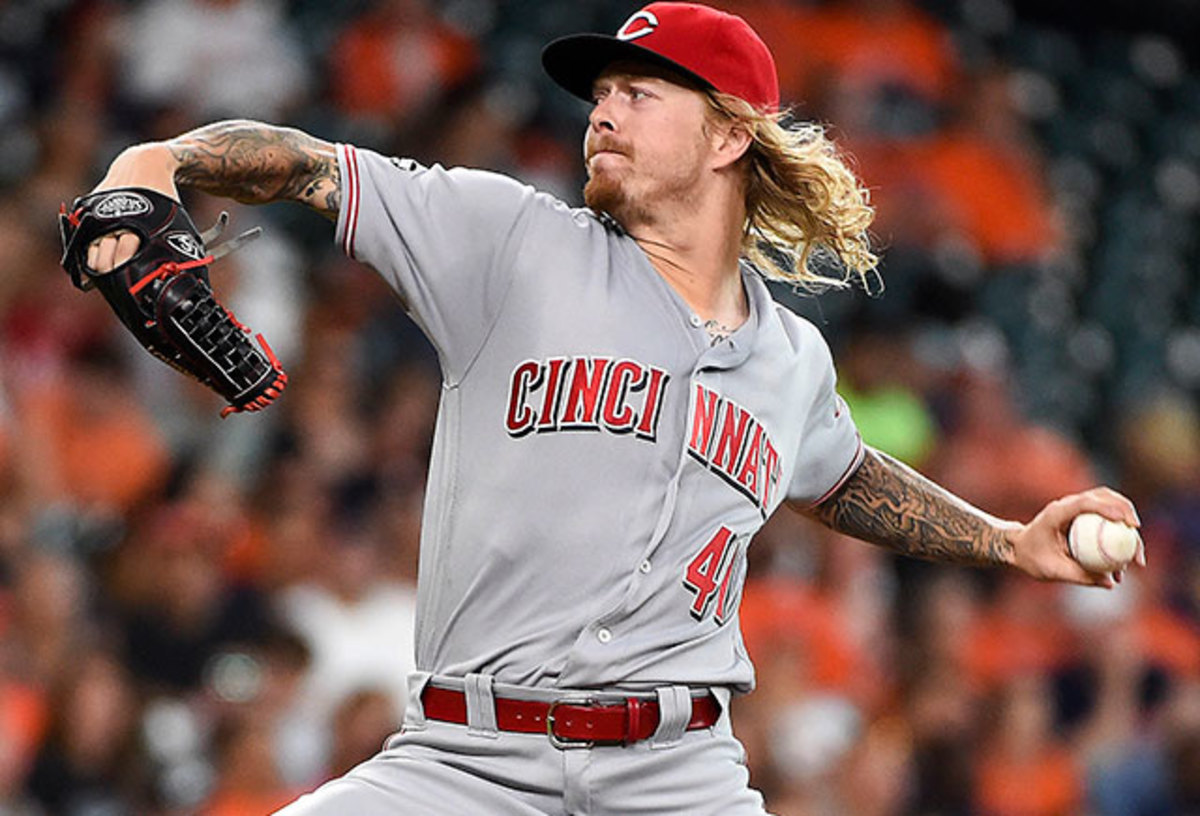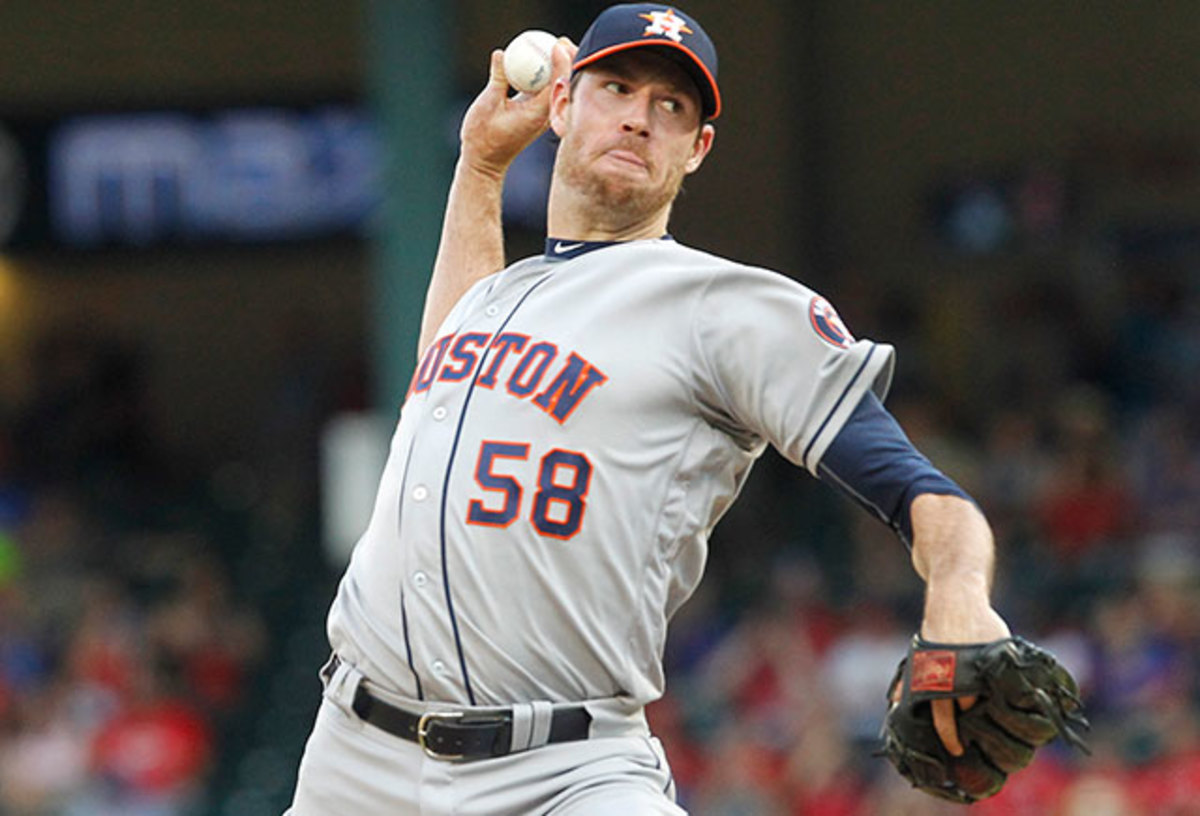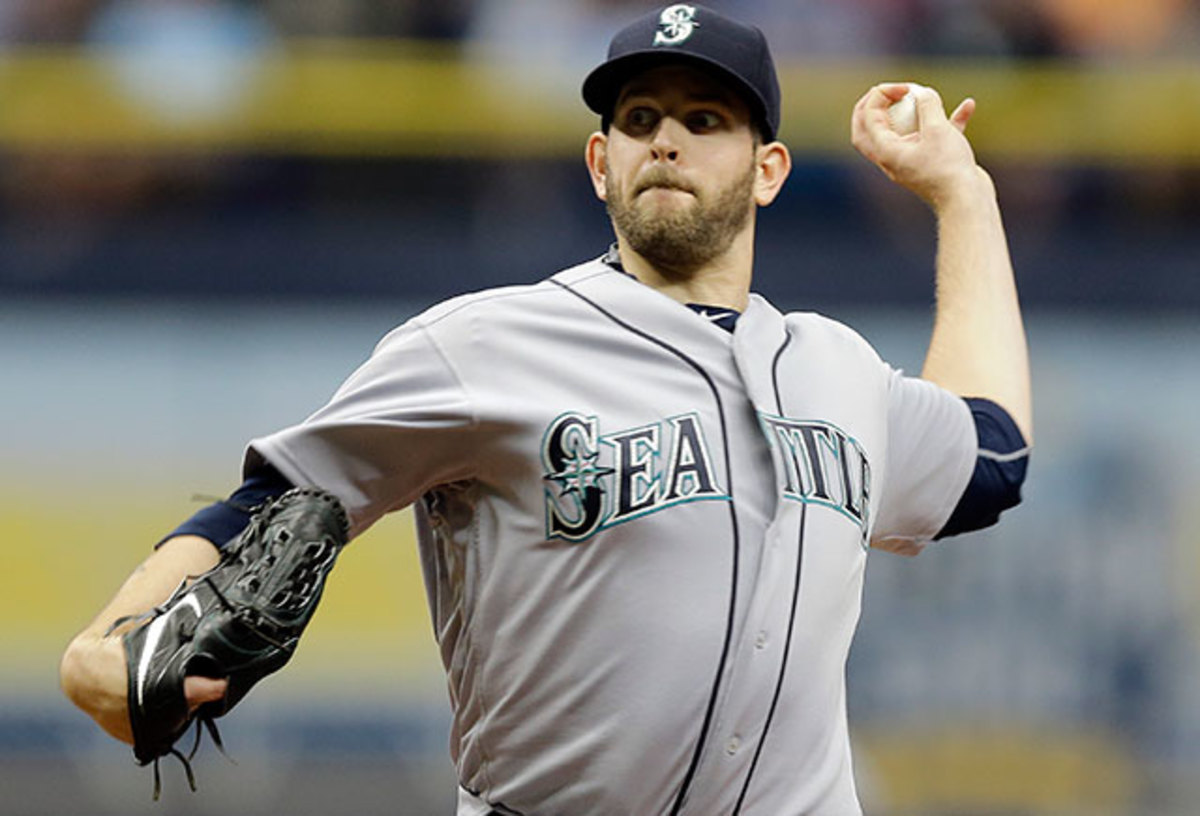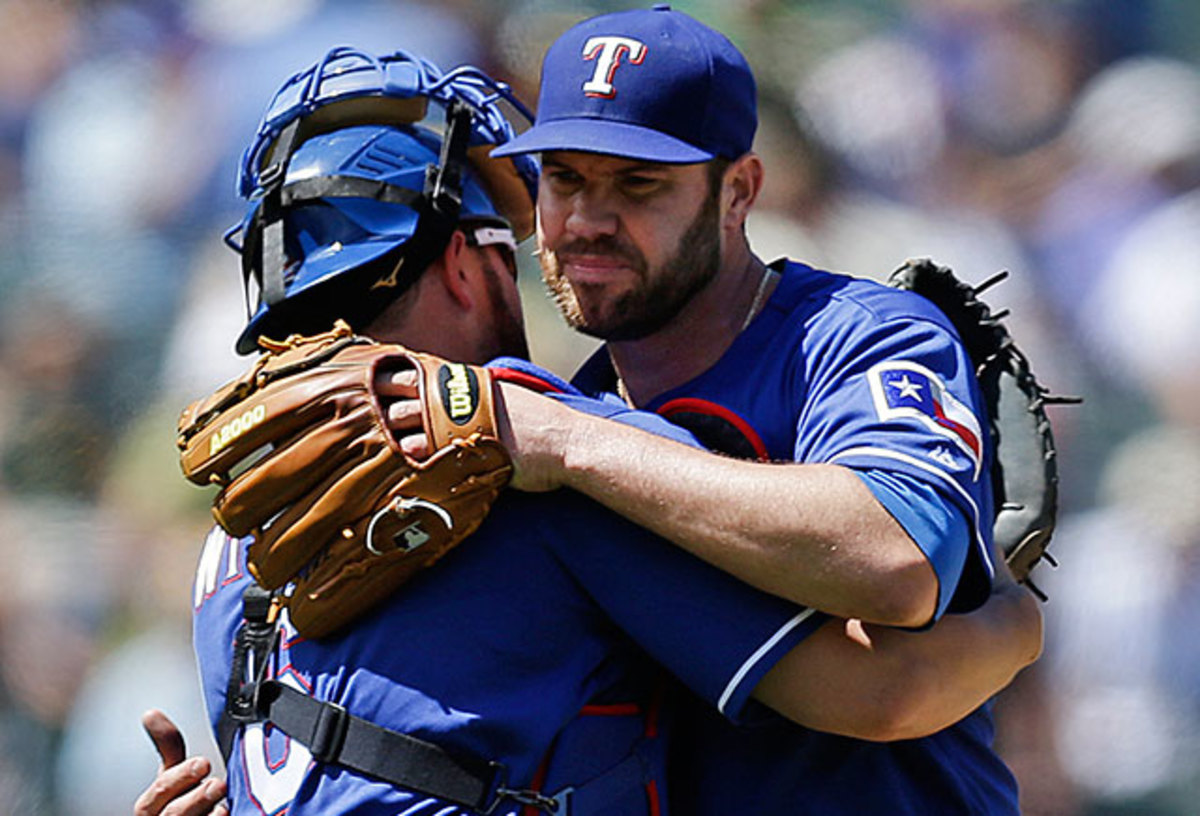The 30: Red-hot Rangers rocket up Power Rankings

You can find all sorts of reasons to explain home field advantage in baseball: A forgiving marine layer, rabid fan support, umpire bias, dumb luck.
This week’s featured teams all own some of the biggest home/road splits in the game. The Reds will keep a close eye on Great American Ball Park’s impact on their rising young starting pitchers. The Astros try to shake their road-game blues to get back into the AL West race after a terrible start. The Rangers need to hope their pitchers keep defying the odds in a stadium that’s less hitter-friendly than it once was. Meanwhile, the Mariners own the flip side of that coin: the biggest home-field disadvantage in the American League.
Turn on your homing devices. It’s Week 11 of The 30.
Best Pitch That Might Be Possessed by Evil Spirits: Jameson Taillon
When Gerrit Cole hit the disabled list last week with a triceps injury, the Pirates had no problem finding a suitable replacement. With some of the most devastating stuff at any level of pro ball and an off-the-charts 61/6 strikeout-to-walk rate at Triple A Indianapolis, Jameson Taillon was already a better bet for big league success than anyone Pittsburgh had in its rotation, except for Cole.
Taillon proved his mettle last Tuesday night. Facing the Mets, the 24-year-old Canadian righthander blazed through eight innings, striking out five and allowing just two hits, one walk, and no runs. The coup de grace came in the second inning. Ahead on Kelly Johnson 1–2, Taillon reared back to fire a fastball. This was no simple heater, though: The two-seamer darted out of the strike zone, diving down and far away from Johnson’s helpless flail. The pitch was essentially a 95-mph screwball, and it was mesmerizing to watch:
Jameson Taillon just struck out Kelly Johnson with this beautiful 95 mph heater with sweet late movement. Wow. pic.twitter.com/3M2DfNDNGZ
— Nick Pollack (@PitcherList) June 14, 2016
Johnson is going to see that pitch in his nightmares for a long, long time.
• Strike Zone Podcast: Cardinals' Matt Carpenter; Ichiro for Hit King?

Red Alert
A passel of intriguing young pitchers is raising optimism in Cincinnati.
30. Minnesota Twins (21–48 record, minus-116 run differential, last week: 29)
29. Atlanta Braves (23–46, minus-96, LW: 30)
28. Cincinnati Reds (27–43, minus-107, LW: 28)
27. Philadelphia Phillies (30–40, minus-101, LW: 25)
26. Oakland A’s (28–41, minus-66, LW: 26)
25. San Diego Padres (29–42, minus-55, LW: 27)
24. Milwaukee Brewers (31–39, minus-58, LW: 22)
23. Los Angeles Angels (31–38, minus-23, LW: 23)
22. Arizona Diamondbacks (32–39, minus-19, LW: 24)
There’s a saying in baseball, one that ably explains the rationale for trades that can end up looking foolish in hindsight: “Flags fly forever.” In other words, you might end up eventually regretting the hot young prospect(s) you give up to consummate a deal, but if you’re a team with championship aspirations, you make the deal anyway. Because when you get down to it, the whole point of obsessing over all of this is to win the pennant, and ideally the World Series, too. Have a legitimate chance to win? Go for it, future consequences be damned.
This is what the Royals did last year. Given a chance to pursue their second straight AL pennant and their first World Series crown in 30 years, Kansas City dealt a raft of quality prospects to land Johnny Cueto and Ben Zobrist at the deadline. The gambit worked, as the Royals went all the way—something that should hopefully comfort Royals fans for a while, given what’s brewing in Cincinnati.
Facing the Astros over the weekend, the Reds trotted out three young, talented young starting pitchers: John Lamb, Cody Reed and Brandon Finnegan. What made the trade remarkable—other than having three major league-caliber starters 25 or under on the same roster—is that Lamb, Reed, and Finnegan were the three pitchers sent to Cincinnati last summer in exchange for Cueto.
• Tim Lincecum has strong debut, but his best years are long gone
Lamb got the weekend started with a strong outing, as the 25-year-old fired 5 1/3 innings, allowing just one run on three hits. He looked wild at times in walking four batters but also struck out eight, the kind of low-contact outing that’s especially welcome for a team that ranks dead last in the NL in Defensive Runs Saved. Lamb has struggled at times in his second season in the majors, allowing 51 hits, 21 walks and seven homers in 47 1/3 innings. But he’s also shown flashes of promise as a back-of-the-rotation type, with just seven earned runs allowed in his past four starts and a nasty curveball that’s held opponents to a .148 batting average (though he hasn’t thrown that many, and hitters are learning to lay off it a bit more).
The 23-year-old Finnegan had already made an impact on the big stage by the time the Reds landed him at last year’s deadline. A first-round pick by the Royals in 2014, Finnegan made it to the mound in K.C. just a few months later as a reliever, then made seven appearances in that fall’s playoffs. The Reds are now wisely using him as a full-time starter, on the theory that 180–200 good innings are worth more than 60–70 very good to great ones. He’s struggled with command for much of the season, chalking up 41 walks in 87 1/3 innings, but like Lamb, Finnegan has improved with reps, allowing just nine runs in five starts before giving up a four-spot on Sunday against the Astros. Between his four-seam and two-seam fastballs, Finnegan throws heat nearly 70% of the time; watch the late movement on his sinker (shown in the first GIF here) and you can see why he goes to it so often.
Reed, 23, could easily become the best of the three, and he offered a glimpse of his potential in his major league debut on Saturday. In seven innings, Reed allowed four runs on six hits, walking three batters and striking out an impressive nine. The scouting reports on Reed are bullish: FanGraphs prospects guru Eric Longenhagen praised his nasty slider and improving changeup, pegging him as a future No. 3 starter, and the Baseball Prospectus crew lauded Reed’s fastball and see top-of-the-rotation potential.
Young pitchers being as volatile and risky as they are, we can’t sit back and expect all three to become stars. But between these intriguing southpaws—as well as Raisel Iglesias, Anthony DeSclafani, scrap-heap surprise Dan Straily and other live arms—The Great American Pitching Experiment looks like it might pay off over the next few years. When your team is well on its way to its second straight season of 90-plus losses, that’s a worthy goal to have.

Comeback Trail
The preseason darling Astros try to claw back into contention after a terrible start.
21. Tampa Bay Rays (31–36, minus-8, LW: 19)
20. Chicago White Sox (33–36, minus-16, LW: 16)
19. Colorado Rockies (32–36, minus-11, LW: 20)
18. New York Yankees (34–35, minus-19, LW: 17)
17. Pittsburgh Pirates (33–35, minus-7, LW: 13)
16. Detroit Tigers (34–35, minus-6, LW: 14)
15. Houston Astros (34–36, minus-6, LW: 21)
14. Miami Marlins (37–32, plus-0, LW: 18)
13. New York Mets (36–32, plus-17, LW: 10)
It looked like it might finally happen: After a miserable April that saw them go 7–17, the Astros had started playing much better. Houston had gone 21–13 thereafter, polishing off a successful mini-homestand with a three-game sweep of the A’s. A couple more wins, and the Astros would be back to .500, creeping closer to striking distance in the AL wild-card race—and maybe eventually the AL West race, too.
Then the team’s old nemesis reappeared, as Houston dropped three out of four in Arlington, part of a road trip that saw it limp to a 4–5 finish. If anything, that result might’ve been better than expected: The Astros had lost to eight straight to the Rangers and 12 in a row at Globe Life Park before that June 8 win.
Blame some ugly road pitching. Opponents are batting .269/.331/.459 against Astros pitching on the road (versus a much stingier .245/.293/.379 at home). Houston’s pitchers have struck out 2 1/2 batters for every one walk on the road, with a strikeout-to-walk rate that soars to 4/1 at home.
The list of culprits is long. Lance McCullers, who spent the first few weeks of the season on the DL, sports a 2.55 ERA at home and a 6.89 mark on the road. Fellow righty starter Mike Fiers sits at 3.67 at home and 6.19 on the road. Swingman Scott Feldman owns a 1.37 ERA at home and a 5.23 ERA on the road. Staff ace Dallas Keuchel has fallen well short of expectations with a 4.46 ERA at home, but he’s been downright awful on the road, with a 5.91 ERA away from Minute Maid Park.
• Watch out, AL East: The Blue Jays' offense is back, and it's back big
One pitcher who’s fared well on the road and who could play an important role in any Houston bounceback is Doug Fister. Signed to a relatively cheap, incentive-laden, one-year, $7 million deal a couple weeks before the start of spring training, Fister was expected to nab the fifth starter’s role (or maybe even simply act as insurance) in a young, talented rotation. Instead, McCullers’s injury, along with struggles by other pitchers, thrust Fister into a higher-profile role. Perennially a soft-tosser who doesn’t strike many batters out, Fister owns the sixth-lowest strikeout rate among AL starters this year. But he’s posted a solid 2.92 ERA on the road (3.26 overall), thanks to two other dramatic splits: He’s dominated righthanded hitters (they’re batting .180/.253/.263 against him, with an OPS 360 points higher by lefthanded hitters) and he’s fared much better with runners on base (.180/.254/.262 against) than he has with the bases empty (.281/.344/.511).
The Astros figure to improve in several other areas, including likely improvements from underachievers Carlos Gomez and Evan Gattis; potential impact callups in first baseman A.J. Reed and infielder Alex Bregman; and 2015 standouts Keuchel and Ken Giles shaking off early struggles (something that has already started to happen). Given how aggressive Houston was at last year’s trade deadline, cashing in some prospects for win-now talent looks likely, too. But given how unlikely it is that Fister can maintain his Houdini act with runners on base, how much ground the Astros have already made up in the standings and how much more work they have left to do, all those improvements can’t come soon enough.

Pitching In
James Paxton leads a starting rotation that’s held up well amid multiple injuries.
12. St. Louis Cardinals (35–33, plus-65, LW: 8)
11. Kansas City Royals (38–31, minus-1, LW: 15)
10. Seattle Mariners (36–33, plus-54, LW: 9)
9. Los Angeles Dodgers (38–33, plus-43, LW: 12)
8. Toronto Blue Jays (39–33, plus-36, LW: 11)
7. Cleveland Indians (38–30, plus-53, LW: 7)
If every team in the AL counted only its road record, the Mariners would sit atop the entire league. But with a lousy 15–18 mark at home, Seattle finds itself sliding down the standings: From a tie for first place 2 1/2 weeks ago to the biggest deficit for any second-place team in the Junior Circuit.
The good news for the Mariners? Even without Felix Hernandez, the starting rotation has fared well lately. Over the past two weeks, M’s starters own the lowest ERA in the AL.
The good tidings start with James Paxton. The Canadian lefthander made Seattle’s rotation on Opening Day in both 2014 and ‘15 only to miss most of each season with injuries. Called up to replace King Felix on June 1, Paxton melted down in his first start against the Padres, allowing eight runs on 10 hits in 3 2/3 innings. He’s rewarded the Mariners for their patience in three starts since then, striking out 22 batters and allowing just one home run, with a 1.96 ERA in 18 1/3 innings. His most impressive outing came against the first-place Rangers on June 11, as Paxton fired 6 1/3 scoreless innings, striking out seven.
• David Wright's latest injury leaves Mets high and dry at third base
Paxton’s rotation mates have been more erratic, though there have been highlights there, too. Taijuan Walker delivered one of the best starts by any pitcher this year on June 8, blanking the Indians over eight innings by allowing just three hits and no walks and fanning 11. Hisashi Iwakuma hasn’t given up fewer than three runs in any of his past five starts, but he’s also pitched seven full innings in each of those outings, providing vital relief for a bullpen that might otherwise become overtaxed.
The enduring challenge lies in the Mariners’ ability to hold on until the cavalry arrives. Hernandez’s timetable has already been pushed back, with the rest needed for his injured heel to heal and a couple of rehab starts adding up to a potential late-July return. Wade Miley could be back from a minor shoulder injury as soon as he’s eligible to vacate the DL on June 28, but replacement Adrian Sampson is an iffy stopgap who got rocked for four runs on eight hits in his major league debut on Saturday. Newly acquired Triple A righthander Zach Lee could see a spot start or two in the majors before long.
Even with the Rangers on pace for 104 wins, the M’s are well positioned to make some kind of playoff run. Getting continued effective pitching from a depleted staff would be pivotal in making that happen.

Texas Two-Step
The AL’s hottest team can’t be stopped at home.
6. Baltimore Orioles (40–28, plus-27, LW: 6)
5. Boston Red Sox (39–29, plus-83, LW: 3)
4. Washington Nationals (43–27, plus-77, LW: 2)
3. San Francisco Giants (44–26, plus-52, LW: 5)
2. Texas Rangers (45–25, plus-42, LW: 4)
1. Chicago Cubs (46–20, plus-166, LW: 1)
The Rangers are playing out of their minds right now: They’ve won six in a row, eight out of nine and 14 out of 17. On May 28, they sat a half-game out of first place; 23 days later, they lead the West by 8 1/2 games.
How has this happened? Let us count the ways.
Colby Lewis is pitching brilliantly. Facing the A’s on Thursday, the veteran righthander fired 7 2/3 perfect innings and carried a no-hitter into the ninth before settling for a complete-game 5–1 win. He now ranks fifth in the AL with a sparkling 2.81 ERA. As much as big-name–free-agent talent has thinned out as teams give players big extensions before they can hit the open market, the Rangers re-signing Lewis on a one-year, $6 million deal ranks as one of the best free-agent deals the game has seen in years. On the other hand, the advanced stats suggest that Lewis’s success won’t last: He owns the eighth-lowest strikeout of any starting pitcher in the AL, with fielding-independent results about a run and a half worse than his ERA.
On the other hand, the Rangers do one thing well that could help Lewis continue to defy the odds: They play terrific defense. Texas leads the AL in Defensive Runs Saved, thanks in large part to the left side of its defense: Third baseman Adrian Beltre, shortstop Elvis Andrus and a passel of leftfielders have accounted for most of the Rangers’ collective defensive excellence. That run-saving prowess comes largely from athleticism and instinct rather than strategy, too, given that among AL clubs, only the A’s have saved fewer runs via defensive shifts than Texas has.
• Where do 2016 Cubs rank against best teams in MLB history?
Nomar Mazara doesn’t rate as highly by advanced defensive metrics, but he’s made several jaw-dropping plays in his rookie season, from homer-saving leaps to game-preserving throws. He’s also been a plus hitter from day one, batting a solid .293/.337/.452 and blasting 11 homers in 61 games. At first, Mazara served as a savior, stepping in when Shin-soo Choo and others hit the disabled list. With most Rangers position players now healthy and back on the field, Mazara remains an important part of the club, and Texas controls his rights through 2021.
There’s more. Just as the Rangers executed a great in-season turnaround last year with their bullpen, they’ve done the same this year, led by Sam Dyson replacing Shawn Tolleson as closer. He's saved 13 games in 14 tries with a 2.04 ERA, allowing less than a base runner an inning. Ian Desmond has been the team’s best all-around player as well as another monster bargain on a one-year, $8 million contract. Fill-ins and part-time players like Ryan Rua and Jurickson Profar have thrived. And like the Ron Washington teams of old, these Rangers can run, ranking sixth in the majors at generating runs on the base paths.
There are reasons to expect regression, from Yu Darvish hitting the DL last week with no timetable for a return to the Rangers taking advantage of lots of hit clustering on offense and hit scattering from their pitchers, both of which typically aren’t sustainable skills. Still, Texas’ first-half rampage has the team on pace for its winningest season ever, where even going only .500 the rest of the way would net a 91-win campaign. A second straight AL West title is the Rangers' to lose.
